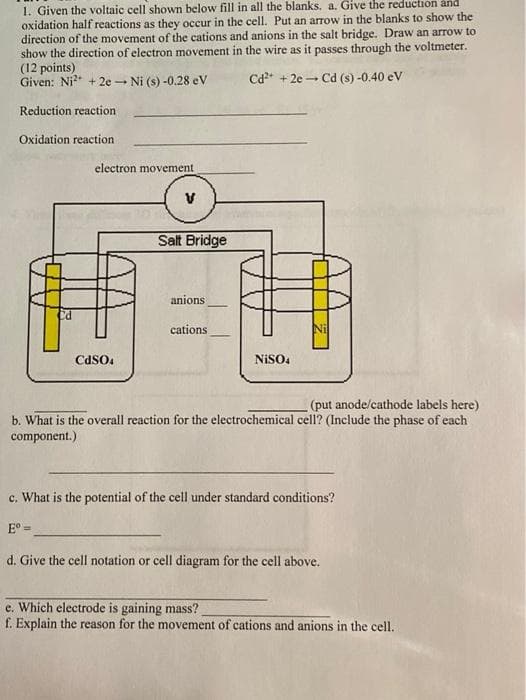1. Given the voltaic cell shown below fill in all the blanks, a. Give the reduction and oxidation half reactions as they occur in the cell. Put an arrow in the blanks to show the direction of the movement of the cations and anions in the salt bridge. Draw an arrow to show the direction of electron movement in the wire as it passes through the voltmeter. (12 points) Given: Ni* + 2eNi (s) -0.28 eV Cd* + 2e - Cd (s) -0.40 eV Reduction reaction Oxidation reaction electron movement Salt Bridge anions cations CdSO. NISO4 (put anode/cathode labels here) b. What is the overall reaction for the electrochemical cell? (Include the phase of each component.) c. What is the potential of the cell under standard conditions? E° = d. Give the cell notation or cell diagram for the cell above. e. Which electrode is gaining mass? f. Explain the reason for the movement of cations and anions in the cell.
1. Given the voltaic cell shown below fill in all the blanks, a. Give the reduction and oxidation half reactions as they occur in the cell. Put an arrow in the blanks to show the direction of the movement of the cations and anions in the salt bridge. Draw an arrow to show the direction of electron movement in the wire as it passes through the voltmeter. (12 points) Given: Ni* + 2eNi (s) -0.28 eV Cd* + 2e - Cd (s) -0.40 eV Reduction reaction Oxidation reaction electron movement Salt Bridge anions cations CdSO. NISO4 (put anode/cathode labels here) b. What is the overall reaction for the electrochemical cell? (Include the phase of each component.) c. What is the potential of the cell under standard conditions? E° = d. Give the cell notation or cell diagram for the cell above. e. Which electrode is gaining mass? f. Explain the reason for the movement of cations and anions in the cell.
Chemistry: An Atoms First Approach
2nd Edition
ISBN:9781305079243
Author:Steven S. Zumdahl, Susan A. Zumdahl
Publisher:Steven S. Zumdahl, Susan A. Zumdahl
Chapter17: Electrochemistry
Section: Chapter Questions
Problem 42E
Related questions
Question

Transcribed Image Text:1. Given the voltaic cell shown below fill in all the blanks, a. Give the reduction and
oxidation half reactions as they occur in the cell. Put an arrow in the blanks to show the
direction of the movement of the cations and anions in the salt bridge. Draw an arrow to
show the direction of electron movement in the wire as it passes through the voltmeter.
(12 points)
Given: Ni* + 2e Ni (s) -0.28 eV
Cd* + 2e - Cd (s) -0.40 eV
Reduction reaction
Oxidation reaction
electron movement
Salt Bridge
anions
cations
CdSO.
NISO4
(put anode/cathode labels here)
b. What is the overall reaction for the electrochemical cell? (Include the phase of each
component.)
c. What is the potential of the cell under standard conditions?
E° =
d. Give the cell notation or cell diagram for the cell above.
e. Which electrode is gaining mass?
f. Explain the reason for the movement of cations and anions in the cell.
Expert Solution
This question has been solved!
Explore an expertly crafted, step-by-step solution for a thorough understanding of key concepts.
This is a popular solution!
Trending now
This is a popular solution!
Step by step
Solved in 2 steps with 1 images

Knowledge Booster
Learn more about
Need a deep-dive on the concept behind this application? Look no further. Learn more about this topic, chemistry and related others by exploring similar questions and additional content below.Recommended textbooks for you

Chemistry: An Atoms First Approach
Chemistry
ISBN:
9781305079243
Author:
Steven S. Zumdahl, Susan A. Zumdahl
Publisher:
Cengage Learning

Chemistry
Chemistry
ISBN:
9781305957404
Author:
Steven S. Zumdahl, Susan A. Zumdahl, Donald J. DeCoste
Publisher:
Cengage Learning


Chemistry: An Atoms First Approach
Chemistry
ISBN:
9781305079243
Author:
Steven S. Zumdahl, Susan A. Zumdahl
Publisher:
Cengage Learning

Chemistry
Chemistry
ISBN:
9781305957404
Author:
Steven S. Zumdahl, Susan A. Zumdahl, Donald J. DeCoste
Publisher:
Cengage Learning


Chemistry & Chemical Reactivity
Chemistry
ISBN:
9781133949640
Author:
John C. Kotz, Paul M. Treichel, John Townsend, David Treichel
Publisher:
Cengage Learning

Chemistry & Chemical Reactivity
Chemistry
ISBN:
9781337399074
Author:
John C. Kotz, Paul M. Treichel, John Townsend, David Treichel
Publisher:
Cengage Learning

Chemistry: Principles and Reactions
Chemistry
ISBN:
9781305079373
Author:
William L. Masterton, Cecile N. Hurley
Publisher:
Cengage Learning